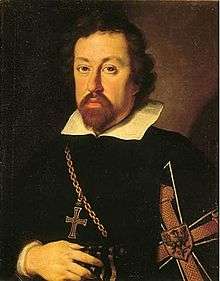Maximilian III, Archduke of Austria
| Maximilian III | |
|---|---|
 | |
| Archduke of Further Austria | |
| Reign | 1612–1618 |
| Predecessor | Matthias |
| Successor | Ferdinand III |
| Born | 12 October 1558 |
| Died | 2 November 1618 |
| House | House of Habsburg |
| Father | Maximilian II, Holy Roman Emperor |
| Mother | Maria of Spain |
Maximilian III of Austria, also known as Maximilian the Grand Master of the Teutonic Knights (12 October 1558 – 2 November 1618) was the Archduke of Further Austria from 1612 until his death.
Biography
Born in Wiener Neustadt, Maximilian was the fourth son of the emperor Maximilian II and Maria of Spain. He was a grandson of Anna of Bohemia and Hungary, daughter and heiress of Vladislaus II of Bohemia and Hungary, who himself was the eldest son of Casimir IV of Poland from the Jagiellonian Dynasty.
From 1585 Maximilian became the Grandmaster of the Teutonic Order; thanks to this he was known by the epithet der Deutschmeister ("the German Master")[1] for much of his later life.
In 1587 Maximilian stood as a candidate for the throne of Polish-Lithuanian Commonwealth, following the death of the previous king, Stefan Batory. A portion of the Polish nobility elected Maximilian king, but, as a result of the rather chaotic nature of the election process, another candidate, Sigismund III Vasa, prince of Sweden, grandson of Sigismund I the Old, was also elected. Maximilian attempted to resolve the dispute by bringing a military force to Poland – thereby starting the war of the Polish Succession. His cause had considerable support in Poland, but fewer Poles flocked to his army than to that of his rival. After a failed attempt to storm Kraków in late 1587, he was defeated in January 1588, at Pitschen in Silesia (Battle of Byczyna) by the supporters of Sigismund III (who had since been formally crowned), under the command of Polish hetman Jan Zamojski. Maximilian was taken captive at the battle and was only released a year and half later after the intervention of Pope Sixtus V in the aftermath of the Treaty of Bytom and Będzin. In 1589, he formally renounced his claim to the Polish crown.[2] The inactivity of his brother, the emperor Rudolf II, Holy Roman Emperor in this matter contributed to Rudolf's poor reputation.
From 1593 to 1595 Maximilian served as regent for his young cousin, Ferdinand, Archduke of Inner Austria. In 1595 he succeeded their uncle Ferdinand II, Archduke of Further Austria in his territories, including Tyrol, where he proved to be a solid proponent of the Counter-Reformation. He also worked to depose Melchior Khlesl, and to ensure that Archduke Ferdinand of Inner Austria, his former charge, succeed as Holy Roman Emperor.
Today, Maximilian is perhaps best remembered for his baroque archducal hat, exhibited in the treasury of the monastery of Klosterneuburg and was used for ceremonial purposes as late as 1835.
He died at Vienna in 1618, and is buried in the canopied tomb in Innsbruck Cathedral.
Ancestors
| 16. Maximilian I, Holy Roman Emperor (=24) | ||||||||||||||||
| 8. Philip the Handsome (=12) | ||||||||||||||||
| 17. Mary of Burgundy (=25) | ||||||||||||||||
| 4. Ferdinand I, Holy Roman Emperor | ||||||||||||||||
| 18. Ferdinand II of Aragon (=26 & 30) | ||||||||||||||||
| 9. Joanna of Castile (=13) | ||||||||||||||||
| 19. Isabella I of Castile (=27 & 31) | ||||||||||||||||
| 2. Maximilian II, Holy Roman Emperor | ||||||||||||||||
| 20. Casimir IV of Poland | ||||||||||||||||
| 10. Vladislaus II of Bohemia and Hungary | ||||||||||||||||
| 21. Elisabeth of Bohemia and Austria | ||||||||||||||||
| 5. Anna of Bohemia and Hungary | ||||||||||||||||
| 22. Gaston de Foix, Count of Candale | ||||||||||||||||
| 11. Anna of Foix-Candale | ||||||||||||||||
| 23. Catherine (de Foix) of Navarre | ||||||||||||||||
| 1. Maximilian III, Archduke of Austria | ||||||||||||||||
| 24. Maximilian I, Holy Roman Emperor (=16) | ||||||||||||||||
| 12. Philip the Handsome (=8) | ||||||||||||||||
| 25. Mary of Burgundy (=17) | ||||||||||||||||
| 6. Charles V, Holy Roman Emperor | ||||||||||||||||
| 26. Ferdinand II of Aragon (=18 & 30) | ||||||||||||||||
| 13. Joanna of Castile (=9) | ||||||||||||||||
| 27. Isabella I of Castile (=19 & 31) | ||||||||||||||||
| 3. Maria of Spain | ||||||||||||||||
| 28. Infante Fernando, Duke of Viseu | ||||||||||||||||
| 14. Manuel I of Portugal | ||||||||||||||||
| 29. Beatriz of Portugal | ||||||||||||||||
| 7. Isabella of Portugal | ||||||||||||||||
| 30. Ferdinand II of Aragon (=18 & 26) | ||||||||||||||||
| 15. Maria of Aragon | ||||||||||||||||
| 31. Isabella I of Castile (=19 & 29) | ||||||||||||||||
References
| Wikimedia Commons has media related to Maximilian III, Archduke of Austria. |
- ↑ In fact, originally the titles Hochmeister ("Grandmaster") and Deutschmeister ("German Master") were different: while Grandmaster was the highest order dignitary, the German Master was the third highest and territorially restricted to area of the Holy Roman Empire (apart from Prussia and Livonia) where he administered its respective bailiwicks. But after 1561 those ranks were united and the Deutschmeister became Grandmaster.
- ↑ Sławomir Leśniewski (January 2008). Jan Zamoyski – hetman i polityk (in Polish). Bellona. pp. 111–118. GGKEY:RRA1L0T4Y81.
| Preceded by Ferdinand II, Archduke of Further Austria Archduke Mathias, his elder brother |
Governor of Tirol Archduke of Further Austria 1612–1618 |
Succeeded by Leopold V, Archduke of Further Austria his first cousin |
| Preceded by Charles II, Archduke of Inner Austria |
Regent of Styria 1593–1595 |
Succeeded by Ferdinand III, Archduke of Inner Austria |
| Preceded by Heinrich von Bobenhausen |
Grand Master of the Teutonic Order 1590–1618 |
Succeeded by Archduke Charles III of Austria |